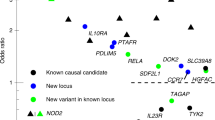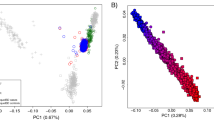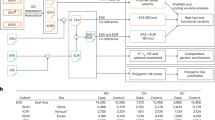Abstract
Inflammatory bowel diseases, Crohn’s disease (CD) and ulcerative colitis are characterised by chronic transmural, segmental and typically granulomatous inflammation of the gut. Each has a peak age of onset in the second to fourth decades of life and prevalence has been increasing significantly in both Western countries and Japan over the last decade, while their pathogenesis remains largely unknown. Recently, positive association of CD with the variants in interleukin 23 receptor (IL23R), autophagy-related 16-like 1 (ATG16L1) genes and chromosome 5p13.1 locus was reported through genome-wide association studies which are now recognised as a robust tool for the identification of susceptibility genes for complex diseases. To examine an association of reported susceptible variants in the three loci with Japanese CD patients, a total of 484 CD patients and 439 controls were genotyped. No evidence of positive association for any of these loci with CD was found in the Japanese population, even after clinically stratified subgroups of CD were used. Our result revealed a distinct ethnic difference of genetic background of CD that we reported previously in other genes between Japanese and Caucasian populations. Further genetic studies are required to confirm our findings with ethnically divergent populations.
Similar content being viewed by others
Log in or create a free account to read this content
Gain free access to this article, as well as selected content from this journal and more on nature.com
or
References
Ahmad T, Armuzzi A, Bunce M, Mulcahy-Hawes K, Marshall SE, Orchard TR, Crawshaw J, Large O, de Silva A, Cook JT, Barnardo M, Cullen S, Welsh KI, Jewell DP (2002) The molecular classification of the clinical manifestations of Crohn’s disease. Gastroenterology 122:854–866
Arnott I DR, Nimmo ER, Drummond HE, Fennell J, Smith BRK, MacKinlay E, Morecroft J, Anderson N, Kelleher D, O’Sullivan M, McManus R, Satsangi J (2004) NOD2/CARD15, TLR4 and CD14 mutations in Scottish and Irish Crohn’s disease patients: evidence for genetic heterogeneity within Europe? Genes Immun 5:417–425
Barrett JC, Fry B, Maller J, Daly MJ (2005) Haploview: analysis and visualization of LD and haplotype maps. Bioinformatics 21:263–265
Croucher PJ, Mascheretti S, Hampe J, Huse K, Frenzel H, Stoll M, Lu T, Nikolaus S, Yang SK, Krawczak M, Kim WH, Schreiber S (2003) Haplotype structure and association to Crohn’s disease of CARD15 mutations in two ethnically divergent populations. Eur J Hum Genet 11:6–16
Duerr RH, Taylor KD, Brant SR, Rioux JD, Silverberg MS, Daly MJ, Steinhart AH, Abraham C, Regueiro M, Griffiths A, Dassopoulos T, Bitton A, Yang H, Targan S, Datta LW, Kistner EO, Schumm LP, Lee AT, Gregersen PK, Barmada MM, Rotter JI, Nicolae DL, Cho JH (2006) A genome-wide association study identifies IL23R as an inflammatory bowel disease gene. Science 314:1461–1463
Friedrichs F, Stoll M (2006) Role of discs large homolog 5. World J Gastroenterol 12:3651–3656
Gasche C, Scholmerich J, Brynskov J, D’Haens G, Hanauer SB, Irvine EJ, Jewell DP, Rachmilewitz D, Sachar DB, Sandborn WJ, Sutherland LR (2000) A simple classification of Crohn’s disease: report of the Working Party for the World Congresses of Gastroenterology, Vienna 1998. Inflamm Bowel Dis 6:8–15
Hampe J, Franke A, Rosenstiel P, Till A, Teuber M, Huse K, Albrecht M, Mayr G, De La Vega FM, Briggs J, Gunther S, Prescott NJ, Onnie CM, Hasler R, Sipos B, Folsch UR, Lengauer T, Platzer M, Mathew CG, Krawczak M, Schreiber S (2007) A genome-wide association scan of nonsynonymous SNPs identifies a susceptibility variant for Crohn disease in ATG16L1. Nat Genet 39:207–211
Hilmi I, Tan YM, Goh KL (2006) Crohn’s disease in adults: observations in a multiracial Asian population. World J Gastroenterol 12:1435–1438
Hugot JP, Chamaillard M, Zouali H, Lesage S, Cezard JP, Belaiche J, Almer S, Tysk C, O’Morain CA, Gassull M, Binder V, Finkel Y, Cortot A, Modigliani R, Laurent-Puig P, Gower-Rousseau C, Macry J, Colombel JF, Sahbatou M, Thomas G (2001) Association of NOD2 leucine-rich repeat variants with susceptibility to Crohn’s disease. Nature 411:599–603
Law NM, Lim CC, Chong R, Ng HS (1998) Crohn’s disease in the Singapore Chinese population. J Clin Gastroenterol 26:27–29
Lennard-Jones JE (1989) Classification of inflammatory bowel disease. Scand J Gastroenterol Suppl 170:2–6
Leong RW, Armuzzi A, Ahmad T, Wong ML, Tse P, Jewell DP, Sung JJ (2003) NOD2/CARD15 gene polymorphisms and Crohn’s disease in the Chinese population. Aliment Pharmacol Ther 17:1465–1470
Leong RW, Lau JY, Sung JJ (2004) The epidemiology and phenotype of Crohn’s disease in the Chinese population. Inflamm Bowel Dis 10:646–651
Lesage S, Zouali H, Cezard JP, Colombel JF, Belaiche J, Almer S, Tysk C, O’Morain C, Gassull M, Binder V, Finkel Y, Modigliani R, Gower-Rousseau C, Macry J, Merlin F, Chamaillard M, Jannot AS, Thomas G, Hugot JP (2002) CARD15/NOD2 mutational analysis and genotype–phenotype correlation in 612 patients with inflammatory bowel disease. Am J Hum Genet 70:845–857
Libioulle C, Louis E, Hansoul S, Sandor C, Farnir F, Franchimont D, Vermeire S, Dewit O, de Vos M, Dixon A, Demarche B, Gut I, Heath S, Foglio M, Liang L, Laukens D, Mni M, Zelenika D, van Gossum A, Rutgeerts P, Belaiche J, Lathrop M, Georges M (2007) Novel Crohn disease locus identified by genome-wide association maps to a gene desert on 5p13.1 and modulates expression of PTGER4. PLoS Genet. 3:e58. Available online at http://www.montefiore.ulg.ac.be/services/stochastic/pubs/2007/Lib07a/Libioulle_2007.pdf
Loftus EV Jr (2004) Clinical epidemiology of inflammatory bowel disease: incidence, prevalence, and environmental influences. Gastroenterology 126:1504–1517
McGovern DP, Butler H, Ahmad T, Paolucci M, van Heel DA, Negoro K, Hysi P, Ragoussis J, Travis SP, Cardon LR, Jewell DP (2006) TUCAN (CARD8) genetic variants and inflammatory bowel disease. Gastroenterology 131:1190–1196
Medici V, Mascheretti S, Croucher PJ, Stoll M, Hampe J, Grebe J, Sturniolo GC, Solberg C, Jahnsen J, Moum B, Schreiber S, Vatn MH (2006) Extreme heterogeneity in CARD15 and DLG5 Crohn disease-associated polymorphisms between German and Norwegian populations. Eur J Hum Genet 14:459–468
Mizushima N, Kuma A, Kobayashi Y, Yamamoto A, Matsubae M, Takao T, Natsume T, Ohsumi Y, Yoshimori T (2003) Mouse Apg16L, a novel WD-repeat protein, targets to the autophagic isolation membrane with the Apg12-Apg5 conjugate. J Cell Sci 116:1679–1688
Ogura Y, Bonen DK, Inohara N, Nicolae DL, Chen FF, Ramos R, Britton H, Moran T, Karaliuskas R, Duerr RH, Achkar JP, Brant SR, Bayless TM, Kirschner BS, Hanauer SB, Nunez G, Cho JH (2001) A frameshift mutation in NOD2 associated with susceptibility to Crohn’s disease. Nature 411:603–606
Ohnishi Y, Tanaka T, Ozaki K, Yamada R, Suzuki H, Nakamura Y (2001) A high-throughput SNP typing system for genome-wide association studies. J Hum Genet 46:471–477
Paavola-Sakki P, Ollikainen V, Helio T, Halme L, Turunen U, Lahermo P, Lappalainen M, Farkkila M, Kontula K (2003) Genome-wide search in Finnish families with inflammatory bowel disease provides evidence for novel susceptibility loci. Eur J Hum Genet 11:112–120
Parham C, Chirica M, Timans J, Vaisberg E, Travis M, Cheung J, Pflanz S, Zhang R, Singh K P, Vega F, To W, Wagner J, O’Farrell A-M, McClanahan T, Zurawski S, Hannum C, Gorman D, Rennick DM, Kastelein RA, de Waal Malefyt R, Moore KW (2002) A receptor for the heterodimeric cytokine IL-23 is composed of IL-12Rbeta1 and a novel cytokine receptor subunit, IL-23R. J Immunol 168:5699–5708
Peltekova VD, Wintle RF, Rubin LA, Amos CI, Huang Q, Gu X, Newman B, Van Oene M, Cescon D, Greenberg G, Griffiths AM, St George-Hyslop PH, Siminovitch KA (2004) Functional variants of OCTN cation transporter genes are associated with Crohn disease. Nat Genet 36:471–475
Podolsky DK (2002) Inflammatory bowel disease. N Engl J Med 347:417–429
Rioux JD, Xavier RJ, Taylor KD, Silverberg MS, Goyette P, Huett A, Green T, Kuballa P, Barmada MM, Datta LW, Shugart YY, Griffiths AM, Targan SR, Ippoliti AF, Bernard EJ, Mei L, Nicolae DL, Regueiro M, Schumm LP, Steinhart AH, Rotter JI, Duerr RH, Cho JH, Daly MJ, Brant SR (2007) Genome-wide association study identifies new susceptibility loci for Crohn disease and implicates autophagy in disease pathogenesis. Nat Genet 39:596–604
Silverberg MS (2006) OCTNs: will the real IBD5 gene please stand up? World J Gastroenterol 12:3678–3681
Stoll M, Corneliussen B, Costello CM, Waetzig GH, Mellgard B, Koch WA, Rosenstiel P, Albrecht M, Croucher PJ , Seegert D, Nikolaus S, Hampe J, Lengauer T, Pierrou S, Foelsch UR, Mathew CG, Lagerstrom-Fermer M, Schreiber S (2004) Genetic variation in DLG5 is associated with inflammatory bowel disease. Nat Genet 36:476–480
Vermeire S, Rutgeerts P (2005) Current status of genetics research in inflammatory bowel disease. Genes Immun 6:637–645
Yamazaki K, Takazoe M, Tanaka T, Ichimori T, Nakamura Y (2002) Absence of mutation in the NOD2/CARD15 gene among 483 Japanese patients with Crohn’s disease. J Hum Genet 47:469–472
Yamazaki K, Takazoe M, Tanaka T, Ichimori T, Saito S, Iida A, Onouchi Y, Hata A, Nakamura Y (2004) Association analysis of SLC22A4, SLC22A5 and DLG5 in Japanese patients with Crohn disease. J Hum Genet 49:664–668
Yamazaki K, McGovern DP, Ragoussis J, Paolucci M, Butler H, Jewell DP, Cardon LR, Takazoe M, Tanaka T, Ichimori T, Saito S, Sekine A, Iida A, Takahashi A, Tsunoda T, Lathrop M, Nakamura Y (2005) Single nucleotide polymorphisms in TNFSF15 confer susceptibility to Crohn’s disease. Hum Mol Genet 14:3499–3506
Yang SK, Hong WS, Min YI, Kim HY, Yoo JY, Rhee PL, Rhee JC, Chang DK, Song IS, Jung SA, Park EB, Yoo HM, Lee DK, Kim YK (2000) Incidence and prevalence of ulcerative colitis in the Songpa-Kangdong District, Seoul, Korea, 1986–1997. J Gastroenterol Hepatol 15:1037–1042
Acknowledgments
We thank Ayumi Kemori and Rie Funahashi and the other members of the Laboratory for Gastrointestinal Diseases for their assistance. This work was supported by a grant from the Japanese Millennium Project and in part by a “Grant-in-Aid for Young Scientists (B)” (grant no. 18790484) from the Ministry of Education, Culture, Sports, Science and Technology (MEXT).
Author information
Authors and Affiliations
Corresponding author
Additional information
The authors declare that they have no competing interests.
Rights and permissions
About this article
Cite this article
Yamazaki, K., Onouchi, Y., Takazoe, M. et al. Association analysis of genetic variants in IL23R, ATG16L1 and 5p13.1 loci with Crohn’s disease in Japanese patients. J Hum Genet 52, 575–583 (2007). https://doi.org/10.1007/s10038-007-0156-z
Received:
Accepted:
Published:
Issue date:
DOI: https://doi.org/10.1007/s10038-007-0156-z
Keywords
This article is cited by
-
Genetic association between IL23R rs11209026 and rs10889677 polymorphisms and risk of Crohn’s disease and ulcerative colitis: evidence from 41 studies
Inflammation Research (2020)
-
NUDT15 R139C causes thiopurine-induced early severe hair loss and leukopenia in Japanese patients with IBD
The Pharmacogenomics Journal (2016)
-
Association of Interleukin-23 receptor gene polymorphisms with susceptibility to Crohn’s disease: A meta-analysis
Scientific Reports (2015)
-
IL23R and ATG16L1 variants in Moroccan patients with inflammatory bowel disease
BMC Research Notes (2014)
-
Characteristics of Japanese inflammatory bowel disease susceptibility loci
Journal of Gastroenterology (2014)



